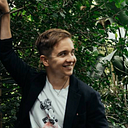The new normal
Yesterday, I visited the National Portrait Gallery in London. I am one of those Londoners who don’t make use of the fact that they are Londoners. Which is to say, I rarely visit places like the NPG or the British Museum. But my wife makes me do those things; she thinks I am a bore, so I make an effort. (And every time, I am eventually glad I did it.)
On the third floor of NPG, there’s a portrait of Samuel Johnson. Otherwise known as Dr Johnson, Samuel is a significant literary figure, especially here in the UK. One of the (many) fathers of the novel form and the author of the first English language Dictionary, a copy of which can be seen on a bookshelf behind the man in the portrait. Much like in Russia, everything can be traced to Pushkin; in Ukraine — to Shevchenko, the Brits are big on Samuel Johnson.
But what surprised me most of all was what was written in the description of the portrait. “The novel,” it said, “was still a relatively new form in the 18th century.” Before, and I am rephrasing, people mainly enjoyed religious texts, songs and plays. Only in the 18th century did the novel appear as a new form of entertainment, labelled by many critics as temporary, much like the TV, the radio, or even the Internet two centuries later.
And this got me thinking. If there was a time in which a novel — a form that many of us in today’s world take for granted — was…
